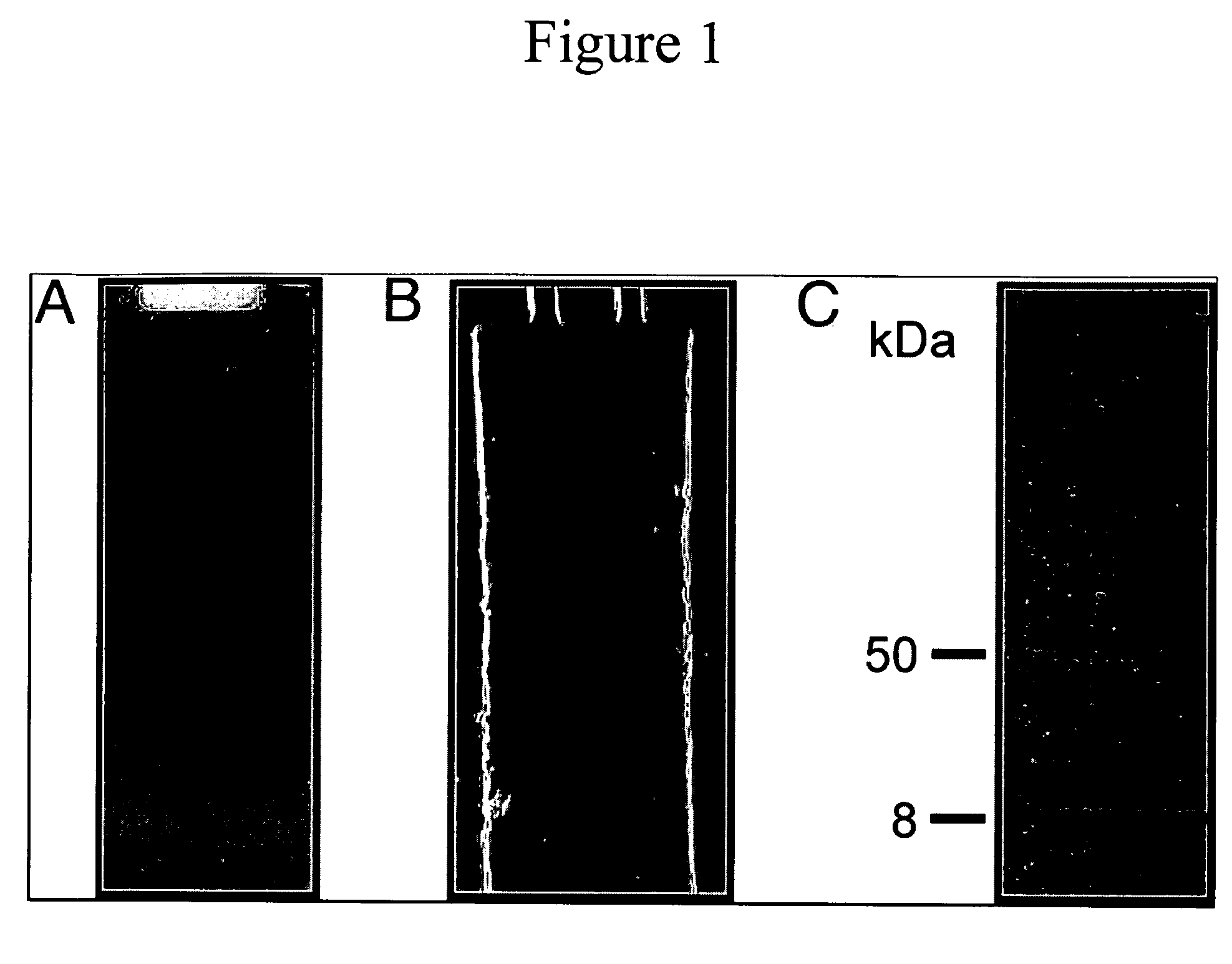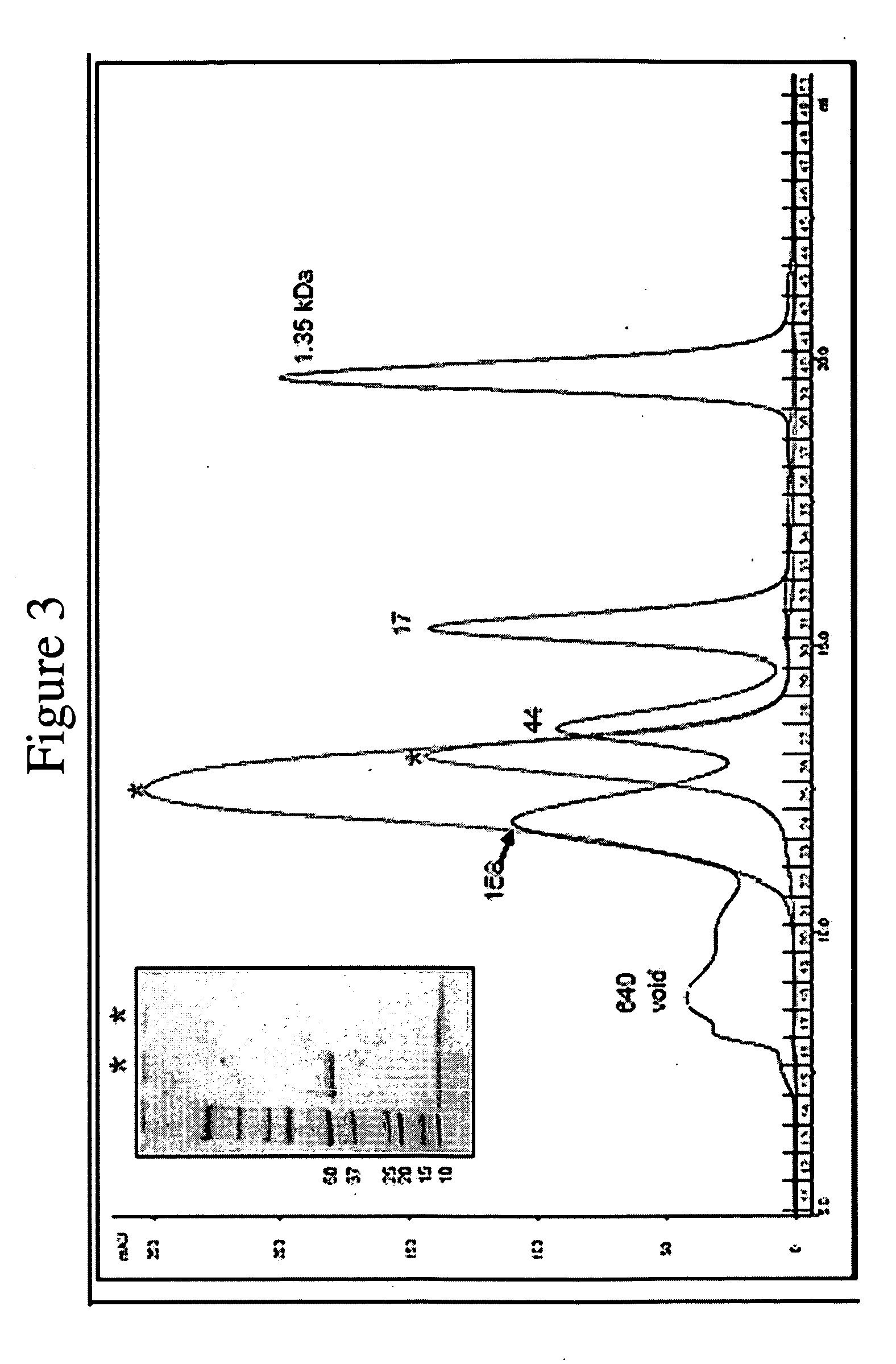Octameric Protein For Use In Bionanotechnology Applications
a bionanotechnology and octameric protein technology, applied in the field of octameric protein for use in bionanotechnology applications, can solve the problem that none of them contains all of the desired attributes
- Summary
- Abstract
- Description
- Claims
- Application Information
AI Technical Summary
Problems solved by technology
Method used
Image
Examples
example 1
Cloning, Expression, Purification and Sequencing of PlyCB
[0094]PlyC Consists of a Heavy Chain (PlyCA) and a Light Chain (PlyCB)—PlyC purified from C1 bacteriophage lysates behaves as a homogeneous protein on native-gel electrophoresis (FIG. 1A). Moreover, this protein band is responsible for the lytic activity, as observed by formation of a clearing zone on an overlay of streptococci-embedded agarose (FIG. 1B). However, SDS / PAGE analysis of the same material on a 4‘20% gradient gel revealed the presence of two bands (FIG. 1C), an approximately 50-kDa heavy chain, termed PlyCA, and an approximately 8-kDa light chain, termed PlyCB, neither of which displayed lytic activity on overlay. N-terminal sequencing of the PlyC heavy and light chains results in two unique sequences (SKKYTQQQYE and SKINVNVENV, respectively), and sequencing of the native band results in a dual sequence, which corresponds exactly to both chains.
[0095]Cloning of PlyC Genes—C1 bacteriophage genome is partially diges...
example 2
Crystal Structure of PlyCB
[0106]Crystallisation of PlyCB—Crystals of the PlyCB octamer are obtained using the hanging drop vapour diffusion method. 0.5 μl of protein solution (10 mg / ml) and 0.5 μl of reservoir buffer (various buffer conditions) are mixed and allowed to equilibrate over 0.5 ml of reservoir buffer at 4° C. Crystals are mounted in nylon cryo loops before being flash-frozen in a nitrogen stream at 100 K. No additional cryo-protectants are used.
[0107]Data Collection, structure determination and refinement—Unless otherwise stated all programs used for structural and crystallographic analysis are located within the CCP4 interface (Potterton et al., 2003) to the CCP4 suite (CCP4, 1995). X-ray diffraction data are measured in house, using a Rigaku RU-H3RHB rotating anode X-ray generator equipped with osmic mirrors and a Rigaku R-Axis IV++ image plate detector. Data collection is carried out at 100 K. The data are processed and scaled using the packages MOSFLM and SCALA (Evan...
example 3
PlyCB Mutants
[0110]Site-Directed Mutagenesis—Specific mutations to plyCB within the plyC operon are made by using the QuikChange site-directed mutagenesis kit (Stratagene) according to the manufacturers instructions. The plasmid inserts are digested out of the resulting clones and recloned into pBAD24, and the full-length inserts are sequenced to confirm that only the desired nucleotide sequence changes had been introduced. Expression of point mutants and wild-type PlyCB are carried out in 0.5% arabinose, as described above.
[0111]Streptococcal-Binding Properties—Five hundred micrograms each of purified of PlyCB is reacted with the carboxylic acid, succinimidyl ester of Alexa Fluor 568, or Alexa Fluor 488 (Molecular Probes) according to the manufacturerλs instructions. Unreacted dye is removed from the labeled protein by application to a 5-ml HiTrap Desalting column (GE Healthcare), and equilibrated with PBS. Streptococcal cultures are grown overnight, washed in PBS, mixed with 50 g ...
PUM
| Property | Measurement | Unit |
|---|---|---|
| diameter | aaaaa | aaaaa |
| diameter | aaaaa | aaaaa |
| diameter | aaaaa | aaaaa |
Abstract
Description
Claims
Application Information
 Login to View More
Login to View More - R&D
- Intellectual Property
- Life Sciences
- Materials
- Tech Scout
- Unparalleled Data Quality
- Higher Quality Content
- 60% Fewer Hallucinations
Browse by: Latest US Patents, China's latest patents, Technical Efficacy Thesaurus, Application Domain, Technology Topic, Popular Technical Reports.
© 2025 PatSnap. All rights reserved.Legal|Privacy policy|Modern Slavery Act Transparency Statement|Sitemap|About US| Contact US: help@patsnap.com



